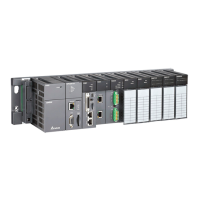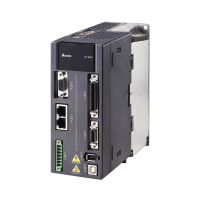AH500 Programming Manual
6-464
If the data in S~S+3 is -123.45, the calculation is as follows.
b15
b0
b7 b8
0016#
S+1
S+2
S+3
D1 +1
.
2D(-)16# 16#31(1)
32(2)16#
33(3)16#
34(4)16#
35(5)16#
2E(.)16#
-
1
2
3
4 5
7
-12345
2
D1
D2
S
If there is 16#20 or 16#30 between the sign character and the first value which is not 0 in the
string, 16#20 or 16#30 is ignored when the string is converted into the binary number.
8
2
-
12345
- 123.45�
Ignored
Number of characters
N
umber of decimal places
Binary number
7
4
12
0.0012
Ignored
Sign
Number of characters
Number of decimal places
Binary number
If 16#2E, which represents the decimal point, is ignored, the string in S should be within the
range between -32768 and 32767. For example, if the string is “1235.3”, users have to check
whether “12353” is within the range.
3. D$VAL:
The operand S occupies seven word devices at most.
The number of characters contained in the string in S should be within the range between 2
and 13.
If there is a decimal point in the string in S, 16#2E should be stored between the first character
after the sign character and the last character.
(D1+1,D1)
.................................... ..............
(D2+1,D2)
(D1+3,D1+2)
S
S+1
S+2
S+3
S+4
S+5
S+6
b15
b0
b7 b8
16#00
Sign
First ASCII code
Second ASCII code
Third ASCII code
Fourth ASCII code
Fifth ASCII code
Sixth ASCII code
Seventh ASCII code
Eighth ASCII code
Ninth ASCII code
Tenth ASCII code
Elevnth ASCII code
Twelfth ASCII code
Sign
First ASCII code
Twelfth ASCII code
Binary number
Number of characters
Number of decimal places

